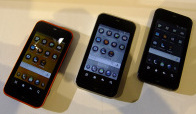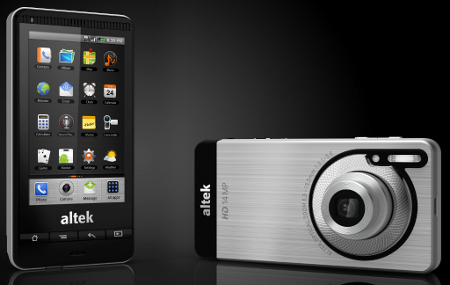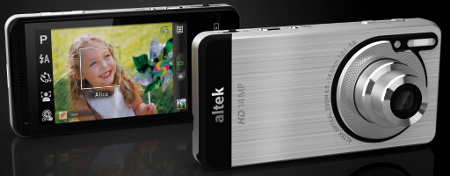Android phones push cameras to 14 megapixels
Oct 4, 2010 — by Eric Brown — from the LinuxDevices Archive — viewsJapanese carrier KDDI announced a November release for a new 3.5-inch, Snapdragon-based “ISO3” Android 2.1 phone from Sharp, touted for its 960 x 640 display and 9.6-megapixel camera. Meanwhile, Altek offered more details on its previously tipped 3.2-inch “Leo” Android phone — including an unprecedented 14-megapixel camera — and said it will ship in Europe in the first quarter of 2011.
While the typical high-end Android smartphones available this fall will offer five- or eight-megapixel cameras, some devices will soon break that barrier. Sharp is introducing the 9.6-megapixel enabled ISO3 Android phone in Japan, and Altek will soon blow that away with a Europe-destined, 14-megapixel "Leo" (see farther below).
KDDI announced that the Sharp-manufactured ISO3 will ship to its Japanese customers around the end of November. This would appear to be Sharp's first Android phone, although it has announced a Galapagos color e-reader tablet that is said to run Android.
KDDI has published some specs for the phone, which features 960 x 640 pixels, a high resolution considering the relatively modest 3.5-inch screen size. According to Ipodnn, this matches the specs of an iPhone 4 and its Apple Retina display, and features the highest resolution found in a non-Apple phone with a 3.5-inch or smaller screen.
The ISO3 offers a second touchscreen sub-panel for Android controls, according to PC-Watch, which kicked in with more details, as well as the photos at right and below. A dual-power mode shows battery status, signal, and missed call notifications without activating the backlight, says the story.
for Android controls, according to PC-Watch, which kicked in with more details, as well as the photos at right and below. A dual-power mode shows battery status, signal, and missed call notifications without activating the backlight, says the story.
The high-resolution primary display is designed to show off images captured by the phone's 9.6-megapixel flash-enabled camera. The camera is touted for its "ProPix" image processing engine, high-quality movie recording, and automated web uploads.

The ISO3 in three colors
Source: PC-Watch
The ISO3 measures 4.76 x 2.48 x 0.49 inches (121 x 63 x 12.6mm) and weighs 4.87 ounces (138 grams), says KDDI. Talk time is 230 minutes, with 200 hours standby, and charging time takes 150 to 160 minutes, claims the company.

ISO3 screens featuring KDDI apps
Altek spins 14-megapixel Leo cameraphone
Camera vendor Altek unveiled its Leo phone in June, but has now released more details, as well as news that it plans to ship the Android 2.1 phone in Europe in the first quarter of 2011. The Leo is claimed to be "the world's first Android-enabled 3.5G smartphone to feature an HD-capable 14-megapixel camera."

Altek Leo
(Click to enlarge)
Other touted features include a variety of modes and effects, including scene, flash, shooting, and video modes, plus face, smile, and blink detection.
The Leo is equipped with Altek's own dual-core "Sunny 9" image processor system-on-chip (SoC), which is claimed to reduce image noise, support high-precision lens focusing, and automatically adjust exposure and optimize white balance. It is unclear whether the Sunny 9 incorporates an ARM core or works with a separate applications processor.

Camera features on the Altek Leo
(Click to enlarge)
The GPS radio is accompanied by navigation and geotagging support, says Altek. The Leo is further equipped with a digital compass, mini-USB 2.0 port, and microSD memory slot that can hold up to 32GB, says the company.
The Leo measures 4.41 x 2.21 x 0.61 inches (111.9 x 56.1 x 15.5 mm) at its thinnest, with the thickness expanding to 0.73 inches (18.5mm), says Altek. The phone is said to weigh 4.94 ounces (140 grams), including the 1020mAh battery pack.
The Leo ships with Android 2.1, and includes email, web browsing, and social media apps, says the company.
Stated JS Liang, Altek vice president and head of R&D, "The challenge facing Altek's design team was how to integrate a fully functioning 14-megapixal camera with 3x optical lens while maintaining Leo's smart phone form factor. An optical lens requires precision moving parts and mechanisms that ensure the device functions properly, but it also has to be attractive and easy to use. We achieved this without compromising Leo's look and feel."
Availability
The Sharp ISO3 will ship in Japan on KDDI's network around the end of November, says PC-Watch. A translated version of KDDI's product page for the ISO3 may be found here.
A translated version of the PC-Watch story on the ISO3 may be found here. The Ipodnn story on the phone may be found here.
The Altek Leo will ship in Europe in 1Q 2011, says the company. The company's product page for the phone may be found here.
This article was originally published on LinuxDevices.com and has been donated to the open source community by QuinStreet Inc. Please visit LinuxToday.com for up-to-date news and articles about Linux and open source.